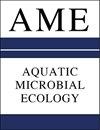Diversity of picoeukaryotes in the eastern equatorial Indian Ocean revealed by metabarcoding
IF 1.1
4区 环境科学与生态学
Q3 ECOLOGY
引用次数: 1
Abstract
We used 18S rRNA gene metabarcoding to investigate picoeukaryotic diversity and distribution at the surface and deep chlorophyll maximum (DCM) of 4 stations in the eastern equatorial Indian Ocean (EEIO). The results showed that picoeukaryotic communities were dominated by 5 phyla: Dinoflagellata, Radiolaria, Chlorophyta, Ochrophyta and Ciliophora. The picoeukaryotic communities were classified into 3 groups matching their water mass origins and depth: (1) Group I was in the surface waters of the Bay of Bengal, which had low salinity, and was dominated by Radiolaria Group A, Spirotrichea and marine stramenopiles; (2) Group II was in the DCM within the intrusion of Arabian Sea high salinity water, in which Chloropicophyceae and Pelagophyceae were more abundant; and (3) Group III was located in the 0°-5°S surface water, which was enriched by Dinophyceae. In addition, Caecitellaceae paraparvulus was abundant at 4°S, where weak vertical mixing occurred. This study provides the first baseline of picoeukaryotic diversity in the EEIO.元条形码技术揭示的东赤道印度洋微真核生物多样性
利用18S rRNA基因元条形码技术,研究了赤道东印度洋(EEIO) 4个站点的表层和深层叶绿素最大值(DCM)的微真核生物多样性和分布。结果表明:微真核生物群落以鞭毛藻门、放射藻门、绿藻门、绿藻门和纤毛藻门5门为主;根据水体来源和深度,将微真核生物群落划分为3个类群:(1)类群位于孟加拉湾表层,盐度较低,以放射菌A群、螺旋体和海洋层菌为主;(2)第II组为阿拉伯海高盐度水体入侵范围内的DCM,其中绿藻科和远洋藻科较为丰富;(3) III组位于0°~ 5°S的地表水中,以Dinophyceae富集。另外,在4°S时,Caecitellaceae paraparvulus丰富,垂直混合较弱。这项研究提供了EEIO中微真核生物多样性的第一个基线。
本文章由计算机程序翻译,如有差异,请以英文原文为准。
求助全文
约1分钟内获得全文
求助全文
来源期刊

Aquatic Microbial Ecology
环境科学-海洋与淡水生物学
CiteScore
3.30
自引率
0.00%
发文量
8
审稿时长
3.0 months
期刊介绍:
AME is international and interdisciplinary. It presents rigorously refereed and carefully selected Research Articles, Reviews and Notes, as well as Comments/Reply Comments (for details see AME 27:209), Opinion Pieces (previously called ''As I See It'') and AME Specials. For details consult the Guidelines for Authors. Papers may be concerned with:
Tolerances and responses of microorganisms to variations in abiotic and biotic components of their environment; microbial life under extreme environmental conditions (climate, temperature, pressure, osmolarity, redox, etc.).
Role of aquatic microorganisms in the production, transformation and decomposition of organic matter; flow patterns of energy and matter as these pass through microorganisms; population dynamics; trophic interrelationships; modelling, both theoretical and via computer simulation, of individual microorganisms and microbial populations; biodiversity.
Absorption and transformation of inorganic material; synthesis and transformation of organic material (autotrophic and heterotrophic); non-genetic and genetic adaptation; behaviour; molecular microbial ecology; symbioses.
 求助内容:
求助内容: 应助结果提醒方式:
应助结果提醒方式:


